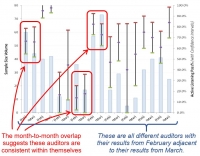Check out some featured articles & videos from StatStuff...
-
What a Fool Believes
Written by Matt HansenRead more...

"What a Fool Believes" is a Grammy award winning song with a wonderful truth we can apply to projects and change management.
-
Galton Board
Written by Matt HansenRead more...

A Galton Board is a great way to illustrate how what appears to be random chaos in the world may consistently form a predictable pattern - a normal distribution (i.e., bell curve).
-
Case Study: Was Amazon's Odd Discount Based on Bad Data?
Written by Matt HansenRead more...

In February 2017, Amazon announced a “BIGTHANKS” coupon saving $8.62 on any order of $50 or more. Why such an odd amount? It’s because they ranked the highest in a “Reputation Quotient” from the Harris Poll of 86.2%. Amazon may be great, but are they statistically the highest?
-
Hannah and DMAIC Methodology (part 1 of 2)
Written by Matt HansenRead more...

The doctor said my 5 year old daughter Hannah had arthritis in her leg and yet it had a very surprising root cause. This bizarre medical issue is one of my favorite ways to describe Lean Six Sigma's DMAIC methodology.
-
Resisting Change
Written by Matt HansenRead more...

It's often said how people resist change, but I actually don't think that's true. Instead, I believe people are resistant to being changed and the control they lose from that change.
-
Lean Six Sigma 101 (Introduction to LSS)
Written by Matt HansenRead more...

The 1981 classic movie "Raiders of the Lost Ark" is a reminder of the balance we need in understanding and applying both Lean and Six Sigma (LSS). We'll review a general introduction and distinction between Lean and Six Sigma are and dive briefly into the DMAIC method for Six Sigma.
-
Win a Bet Using Benford's Law (1 of 2)
Written by Matt HansenRead more...

Here's a great way you can win a bet with your friends at least 2 out of 3 times using Benford's law. Try this out and then check out my next video that explains why this works.
-
Dead Right But Still Dead
Written by Matt HansenRead more...

Have you ever been "dead right" about something but still encounter resistance? It reminds me of one of my favorite quotes how "you can be dead right, but still dead".
-
Case Study: Analysis of Data Inconsistency Saved $15 Million/Yr
Written by Matt HansenRead more...

A telecommunications company terminated a $15M/yr contract with a self-proclaimed “Six Sigma” vendor when it was statistically proven the vendor used biased and inconsistent methods to audit their customer service calls. The vendor’s inconsistent data collection methods meant their data and any analysis on their data were unreliable and irrelevant.











